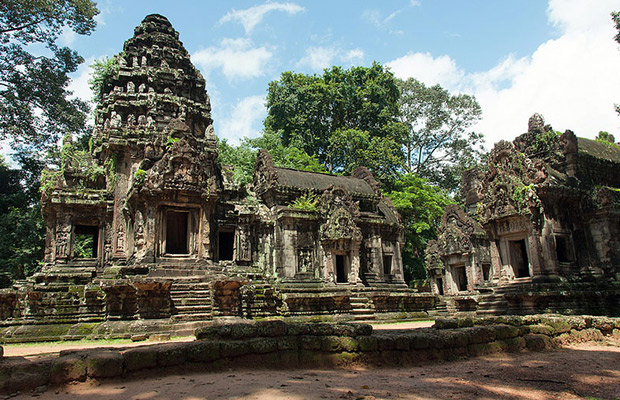
- Travel Name: Thommanon Temple
- Travel Destination: Siem Reap
Thommanon is a small, gorgeous representation of Angkor architecture. In the 1960’s, the temple was the focus of a meticulous restoration project. As a result, some extremely fine examples of Khmer artwork, hieroglyphs, and architecture can be viewed at Thommanon.
After studying the temple’s design and stonework, archeologists have concluded that Thommanon was erected shortly before the more famous Angkor Wat temple was built. The beauty and success of Thommanon was almost certainly a major source of inspiration for the architects of Angkor Wat.
Thommanon’s weathered sandstone appears to glow in the light of the setting sun. In the late afternoon, the temple’s main tower gives off hues of salmon, deep red, oxidized copper, and tan. Make sure your camera has a full roll of film or a large memory card, because you’ll want to take plenty of pictures.
You will first enter Thommanon from the east, after which you will pass through a gopura (a Hindu temple gateway). From the gopura you will walk through a mandapa, or outdoor hallway, and into a stunning antechamber. The antechamber opens up to the grand central sanctuary. A massive Angkor-style prasat (tower) sits atop the central sanctuary. Standing beneath this well-preserved prasat, you will feel humbled and awe-stricken by the efforts of the ancients.
History of Thommanon
Scholars studying the carvings of the devatas in Thommanon have concluded that Thommanon was built around the time when work on Angkor Wat was begun.However, there is some disagreement as to the precise date it was built. Some believe that the distinctive carvings of females, known as devatas indicate that they were built during the reign of Jayavarman VI (1080–1113 AD), some time at the end of the 11th century. However, there is greater agreement, especially given the scholarly studies that it was built by Suryavarman II around the time of Angkor Wat and Beng Mealea from 1,113–1,150 AD
The Vaishnavite cult was adopted in Cambodia by Jayavarman II and his son Jayavarman III. Under these two rulers, the shaivite cult was subsumed with the Vaishnavite cult in the temples such as the Thommaman, Beng, Melea, Chausey, Tevoda, Bantay Samre, and Angkor Vat.
Thommanon is located directly opposite the Chau Say Tevoda and just 500 metres east of the Victory Gate on the way to Ta Keo. In the 1960s, the temple underwent a full restoration, funded by the École française d'Extrême-Orient (EFEO). French archaeologists restored it and added concrete ceilings.
Structure of Thommanon
Thommanon is a single-towered temple with an east-facing central sanctuary, crowned by a prasat, or tower. Access from the east is via a gopura, followed by a mandapa, or antechamber, before arriving at the central sanctuary. The temple's carvings are very well preserved and the aged sandstone provides a distinct contrast to the surrounding jungle. The architectural style of its tower is also akin to the Angkor Wat temple and the Chau Say Tevoda in its vicinity.[6] The temple is much better preserved than the nearby Chau Say Tevoda, which is undergoing restoration, though both temples are similar in design. The reason for better preservation of Thommanon is attributed to the fact that its superstructure does not have stone-enclosed wood beams. Thus, adoption of sandstone as the medium for carvings in this temple has made it more advanced in its architectural design vis-à-vis other temples in its vicinity, which were mostly wood-based. All doorways include carved pediments.
The compound walls around the temple have all disappeared, leaving only the entry gates on the east and the west; the central tower is all that remains of the main temple. It is inferred that both Thommanon and Chau Say Thavoda were interlinked to the central tower under one large compound with large gates. The independent building separated from the main temple was the library.
Left: Female Devatas in a corner panel depiction with two different types of Skirts. Right: More depictions of female Devatas.
Images of Devatas, the female divine carved figurines, are seen in profusion here, as in other Khmer temples. They are the centre of attraction in Thommanon. The devatas depict flower crowns, sampots (Cambodian skirts), necklaces, armbands, belts and ankle bands.[4] The mudras displayed are complex. The devatas grip the flower very distinctively, holding the ring and middle fingers against the thumb, while the index and small finger are extended. One Angkor researcher calls this position the "devata mudra", and notes it is also prominent at Angkor Wat.[4] The sampots of the devatas though are divided into two distinct types of sampot, one type is the ancient pleated style, seen in the Bakheng period at Lolei and Phnom Bok (900 AD), and the other is a patterned fabric style with folds and "tail" seen at Angkor Wat.
Getting There: Coming from Angkor Thom, Thommanon is located opposite Chau Say Tevoda. From Ta Keo, Thommanon is located 500 meters east of the Victory Gate to Ta Keo.

Copyright © 2025, Cambo Tours & Travel - Discover Authentic Travel Experience, All Rights Reserved.